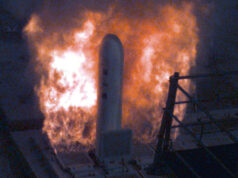Typhoon jets deployed in Estonia were scrambled twice over the weekend to intercept Russian fighter aircraft.
The aircraft did not enter Estonian airspace.
The Ministry of Defence said that Typhoon jets on QRA alert launched during the evening of Friday the 14th of June to intercept a Russian SU-30 fighter aircraft that was flying to the north of Estonia.
A Typhoon pilot from XI(Fighter) Squadron said in a release:
“We were scrambled to intercept a contact close to Estonian airspace in the early evening, between two periods of poor weather. Shortly after getting airborne we came alongside a SU-30 Flanker fighter aircraft. We escorted the fighter over the Baltic sea, around Estonia and passing over another Russian military transport aircraft in the process.”
Crews made a second scramble on Saturday the 15th of June to intercept a Russian SU-30 Flanker fighter and an Ilyushin IL-76 Candid transport aircraft transiting north from Kaliningrad towards Estonian and Finnish airspace.
The pilot added:
“We scrambled to intercept two contacts that were approaching Estonian airspace from the south. We escorted the two aircraft for 15 minutes as they transited back towards mainland Russia. We then handed over responsibility to two Finnish QRA aircraft, which had also been scrambled as the Russian aircraft operated on the airspace boundary between Estonia and Finland.”
During both intercepts, the aircraft were flown at a safe distance and operated in a professional manner throughout.
The Royal Air Force is deployed on Operation AZOTIZE in Estonia in support of NATO Baltic Air Policing.













EJ230 engines with the inclusion of conformal fuel tanks would make a big difference in this type of scenario. Captor-E Radar testing at present while thrust vectoring has been available for some time now.
An amazing aircraft, with plenty of potential still left!
“AESA technology could migrate to electronic warfare equipment”
https://www.janes.com/article/89293/aesa-technology-could-migrate-to-electronic-warfare-equipment
Should our defence budget ever reach the lofty heights of 3% GDP, I would like to see a batch of block 4 Typhoons ordered ( with blocks 2 and 3 brought up to the same standard), with many of the attributes mentioned by Nigel in his post above.
I don’t think I would bother with thrust vectoring as I am yet to be convinced of its merits, I think it just turns you into a large floundering target…
But advanced AESA, with electronic attack capability, could unlock tremendous possibly.
Captor E (with advanced UK additions) and supporting cutting edge avionics, should be 10 years in advance of F35 and 25 years ahead of the fixed radar architecture of the F22 (upgrades aside).
Conformal fuel tanks and upgraded engines ( thrust, fuel economy and TBO improvements)
Single piece display, advanced distribution sensors and next gen optronics
Such a beast would truly blur the boundaries between gen 4 + and gen 5 and be a stepping stone towards Tempest…
It would be an exceptionally capable aircraft, one that’s perfectly viable and very exportable … Is the will and the money there to push Typhoon to the next level?
We will see….
You might find this link interesting John Clark. Fully agree with your post apart from TVN!
https://www.flightglobal.com/news/articles/eurojet-pushes-thrust-vectoring-technology-for-typhoon-333501/
This is an interesting article too.
https://www.aerosociety.com/news/wearable-cockpits-the-ultimate-human-machine-interface/
Totally agree, TVN brings a lot of benefits to the party, regardless of low speed aerobatics.
For Tempest this would be pre-requisite, as it can help with the aircraft’s stealth by reducing the number of fight control surfaces required.
The Sukhoi truly is a beautiful aircraft.
Remember the old adage, ‘If it looks right, it is right.’ I firmly believe in trickle manufacturing to retain excellence and capability. We are a long time from the next generation fighter, and I would recommend a small workforce on the Typhoon assembly at Warton (once current orders are completed) is occupied with either upgrading, or brand new build, to maintain our logistic strength?